Mikimoto: Masterful pearl craftsmanship
On Tuesday, June 25th, Mikimoto unveils its new Haute Joaillerie collection during Haute Couture Week. Driven by the precepts of its founder, Kokichi Mikimoto, inventor of the cultured pearl, the House pursues its quest for beauty and excellence, achieved through exceptional craftsmanship.
Place Vendôme, the beating heart of fine jewellery, is home to Mikimoto’s Paris boutique. Each piece on display in this pearly-walled store bears witness to meticulous craftsmanship and the exceptional quality of the pearls. “We only keep ten percent of the pearls we harvest,” explains Flaviène Barbier, the company's general manager since 1997. She began her career learning her trade with the great names in jewellery before taking over the reins of the Mikimoto House, “the greatest,” she says with a smile. She explains that founder Kokichi Mikimoto worked for 30 years before succeeding in cultivating the first semi-spherical pearl in 1893. He was a pioneer, registering the world's first biological patent. A pioneer, Mr Mikimoto purchased the poor-quality pearls and burned them in public. This quest for perfection has been an essential pillar of the House since it was founded. Even today, the meticulous sorting of the pearls collected is an obvious example. “The pearls we keep must be completely circular, without marks or flaws. Only the human eye can distinguish the nacre and lustre of Mikimoto pearls," Barbier explains.
“Pearls require an education. Just as we educate ourselves in other arts, we educate ourselves about beauty.”
Entitled “The Bows,” the House's new Haute Joaillerie collection celebrates the sophisticated elegance of bows and ribbon, key elements in the Haute Couture range. “The knot represents elegance,” says Barbier. The knot epitomises both prestige and free creativity, whether the pageantry of the Court, Yves Saint Laurent's symbol of feminine emancipation, or the extravagance and swirling creativity of John Galliano at Christian Dior. This theme also echoes the knot meticulously integrated between each pearl in a Mikimoto piece, a symbol of exceptional craftsmanship and tradition.
“In Tokyo, 30 designers work together in the ateliers to bring these unique creations to life. A major research project was carried out on Mikimoto archives, art deco drawings, which have been reworked,” explains Barbier. “They are all unique pieces. The stones are very important and cannot be recovered.” The pieces are made in the Mikimoto workshop in Japan. Then, the House usually presents its Haute Joaillerie collections in its Paris boutique. This season, the pieces will cross the Place Vendôme to be exhibited at the Hôtel d'Évreux, by invitation only. The collection will first be exhibited in Paris, followed by a second presentation in Tokyo.
“It's the eye, it's the hand. Artificial intelligence will have a hard time with us.”
Behind the scenes at Place Vendôme, expert hands are in full swing. Rachid Jammoua, affectionately nicknamed Monsieur Rachid, or “our artist” as Barbier introduces him, has been embodying and magnifying this craft for more than 30 years, with a precision and dexterity that have become legendary. Jammoua can make a necklace in 20 minutes that would normally take several hours to assemble for nonexpert hands. “I don't use a needle. I just coat the wire with a mixture of glue and thread it on,” he explains. He began his apprenticeship studying with the venerable Suzuki-san, a journey that led him to the United States and Japan to perfect his craft. He remains the only one who masters this exceptional skill with such agility in Paris. He started transmitting his knowledge four years ago and is still the only one who adjusts necklaces on customers. “It calms me down,” says the exceptional craftsman with a wide grin. The regular customers of the House know him well. “Customers ask 'Is Mr Rachid in?’ I really admire his work. He does things without looking like he's doing them,” says Barbier, eyeing Jammoua with warmth. “It's the eye, it's the hand. Artificial intelligence will have a hard time here,” she insists.
“Pearls are a real danger. Once you start, it's difficult to resist.”
“Pearls are very intimate. You heat it with your skin, then it cools down. You nestle against it,” explains Barbier. At Mikimoto, each pearl is far more than a piece of jewellery: it's a heritage, a tradition transmitted from generation to generation. “You have to be careful about the fragrance. But when a young girl inherits her mother's pearls, she takes great care of them," she explains. The House has stood the test of time through elegance and restraint. “Our customers don't need any showboating. When you know our expertise and our exacting standards, there's no need to go overboard,” she says.
In the world of Haute Joaillerie, Mikimoto has earned its reputation as the guardian of the sea’s treasures. Behind each creation stand dedicated craftsmen like Jammoua, whose exceptional skills magnify exceptional materials. Mikimoto's international recognition speaks for itself: “Other boutiques on Place Vendôme sometimes direct their customers interested in pearls to our boutique. It even happens that the saleswomen personally accompany customers to our door. This is the Mikimoto pearl.”



